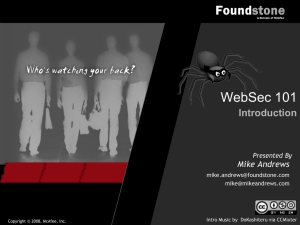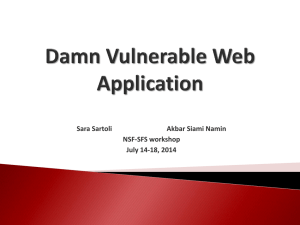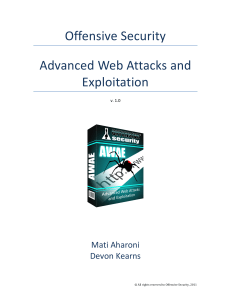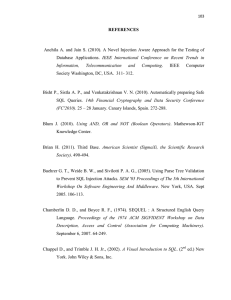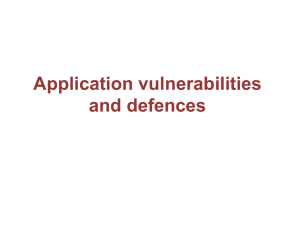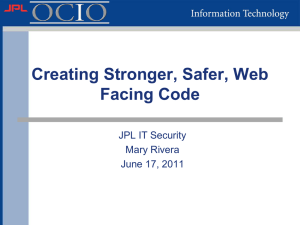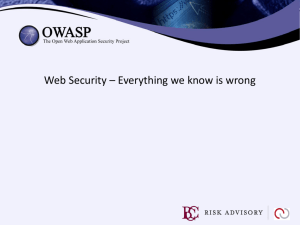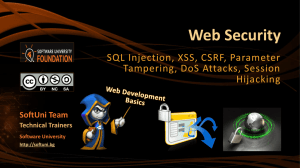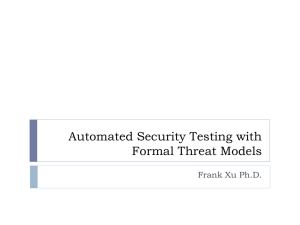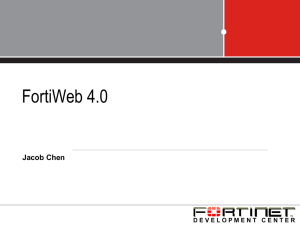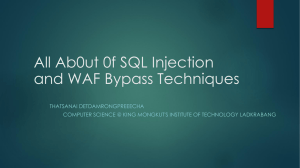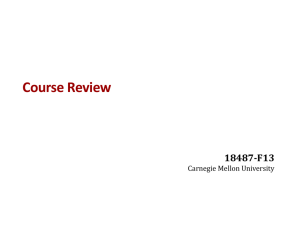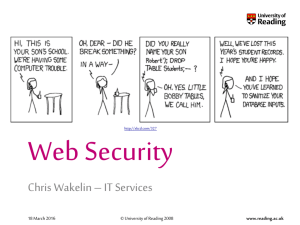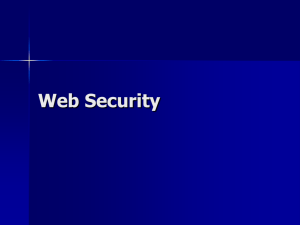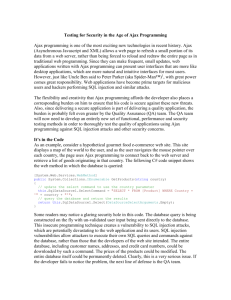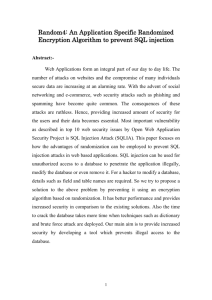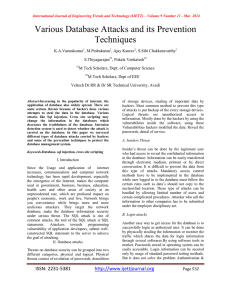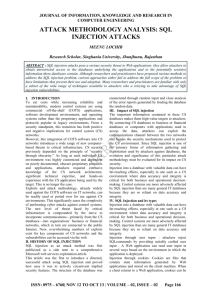Chapter 3
advertisement
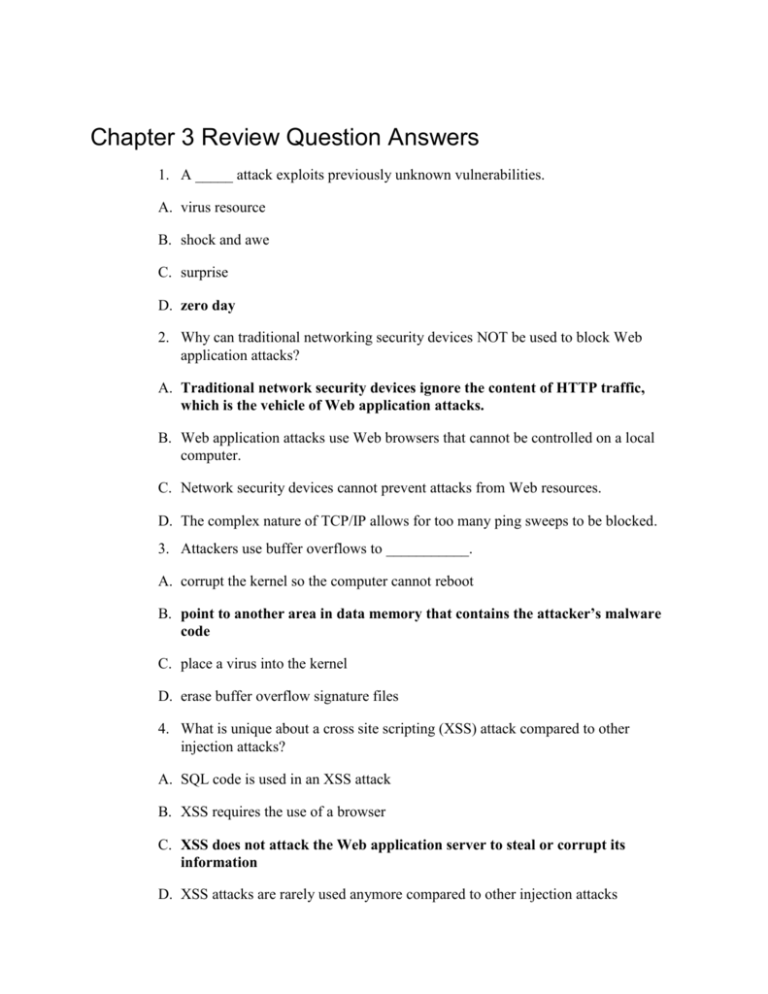
Chapter 3 Review Question Answers 1. A _____ attack exploits previously unknown vulnerabilities. A. virus resource B. shock and awe C. surprise D. zero day 2. Why can traditional networking security devices NOT be used to block Web application attacks? A. Traditional network security devices ignore the content of HTTP traffic, which is the vehicle of Web application attacks. B. Web application attacks use Web browsers that cannot be controlled on a local computer. C. Network security devices cannot prevent attacks from Web resources. D. The complex nature of TCP/IP allows for too many ping sweeps to be blocked. 3. Attackers use buffer overflows to ___________. A. corrupt the kernel so the computer cannot reboot B. point to another area in data memory that contains the attacker’s malware code C. place a virus into the kernel D. erase buffer overflow signature files 4. What is unique about a cross site scripting (XSS) attack compared to other injection attacks? A. SQL code is used in an XSS attack B. XSS requires the use of a browser C. XSS does not attack the Web application server to steal or corrupt its information D. XSS attacks are rarely used anymore compared to other injection attacks 5. Each of the following can be used in an XSS attack except _____________. A. HTML B. JavaScript C. Adobe Flash D. ICMP 6. A cookie that was not created by the Web site being viewed is called a ___________. A. first-party cookie B. second-party cookie C. third-party cookie D. fourth-party cookie 7. The basis of a SQL injection attack is ___________. A. to inject SQL statements through unfiltered user input B. to have the SQL server attack client Web browsers C. to link SQL servers into a botnet D. to expose SQL code so that it can be examined 8. Which of the following cannot be performed through a successful SQL injection attack? A. Display a list of customer telephone numbers B. Discover the names of different fields in a table C. Erase a database table D. Reformat the Web application server’s hard drive 9. A markup language that is designed to carry data is ___________. A. ICMP B. HTTP C. HTML D. XML 10. When an attacker can access files in directories other than the root directory this is known as a(n) _____ attack. A. Command injection B. Directory traversal C. SQL injection D. XML injection 11. A(n) _____ attack modifies the fields that contain the different characteristics of the data that is being transmitted. A. HTML packet B. SQL injection C. XML manipulation D. HTTP header 12. Which of the following cookies only lasts for the duration of visiting the Web site? A. Session B. Persistent C. Temporary D. RAM 13. What is a session token? A. A random string assigned by a Web server B. The same as a third-party cookie C. A unique identifier that includes the user’s e-mail address D. XML code used in an XML injection attack 14. Which of the following is not a security concern of the ActiveX add-on? A. The person who signed the control may not have properly assessed the control’s safety. B. A malicious ActiveX control can affect all users of that computer. C. ActiveX can be integrated with JavaScript. D. ActiveX does not have safeguards and has full access to the Windows operating system. 15. Which of the following is not a DoS attack? A. Ping flood B. SYN flood C. Push flood D. Smurf 16. What type of attack intercepts legitimate communication and forges a fictitious response to the sender? A. Man-in-the-middle B. Interceptor C. SQL intrusion D. SIDS 17. A replay attack ___________. A. makes a copy of the transmission for use at a later time B. replays the attack over and over to flood the server C. can be prevented by patching the Web browser D. is considered to be a type of DoS attack 18. _____ is used to discover the MAC address of a client based on its IP address. A. Ping B. ICMP C. DNS D. ARP 19. DNS poisoning ___________. A. is rarely found today due to the use of host tables B. can attack an external DNS server C. is the same as ARP poisoning D. floods a DNS server with requests until it can no longer respond 20. _____ involves using a third party to gain access rights. A. Transitive access B. Privilege escalation C. Active Rights Scaling (ARS) D. Directory traversal
